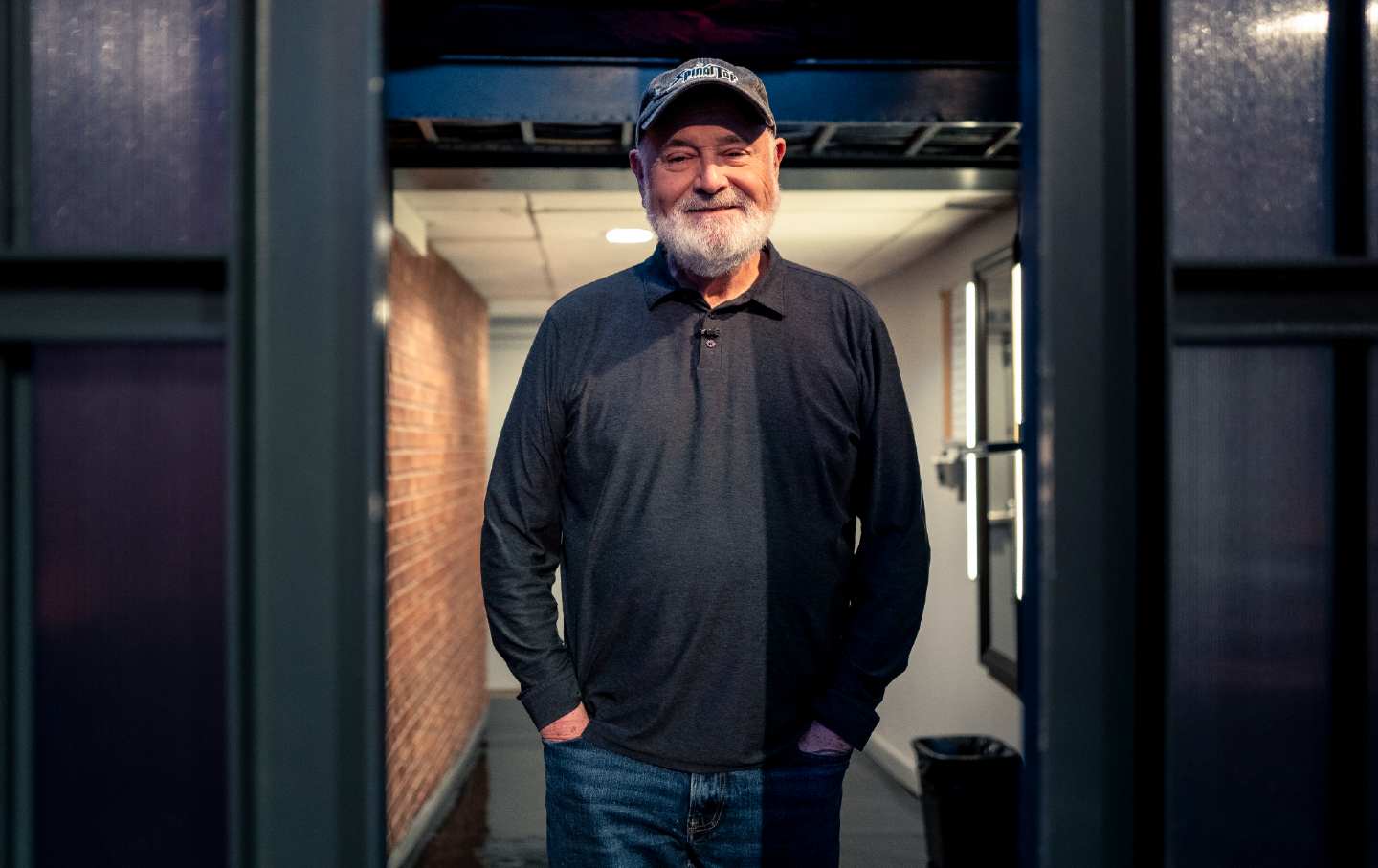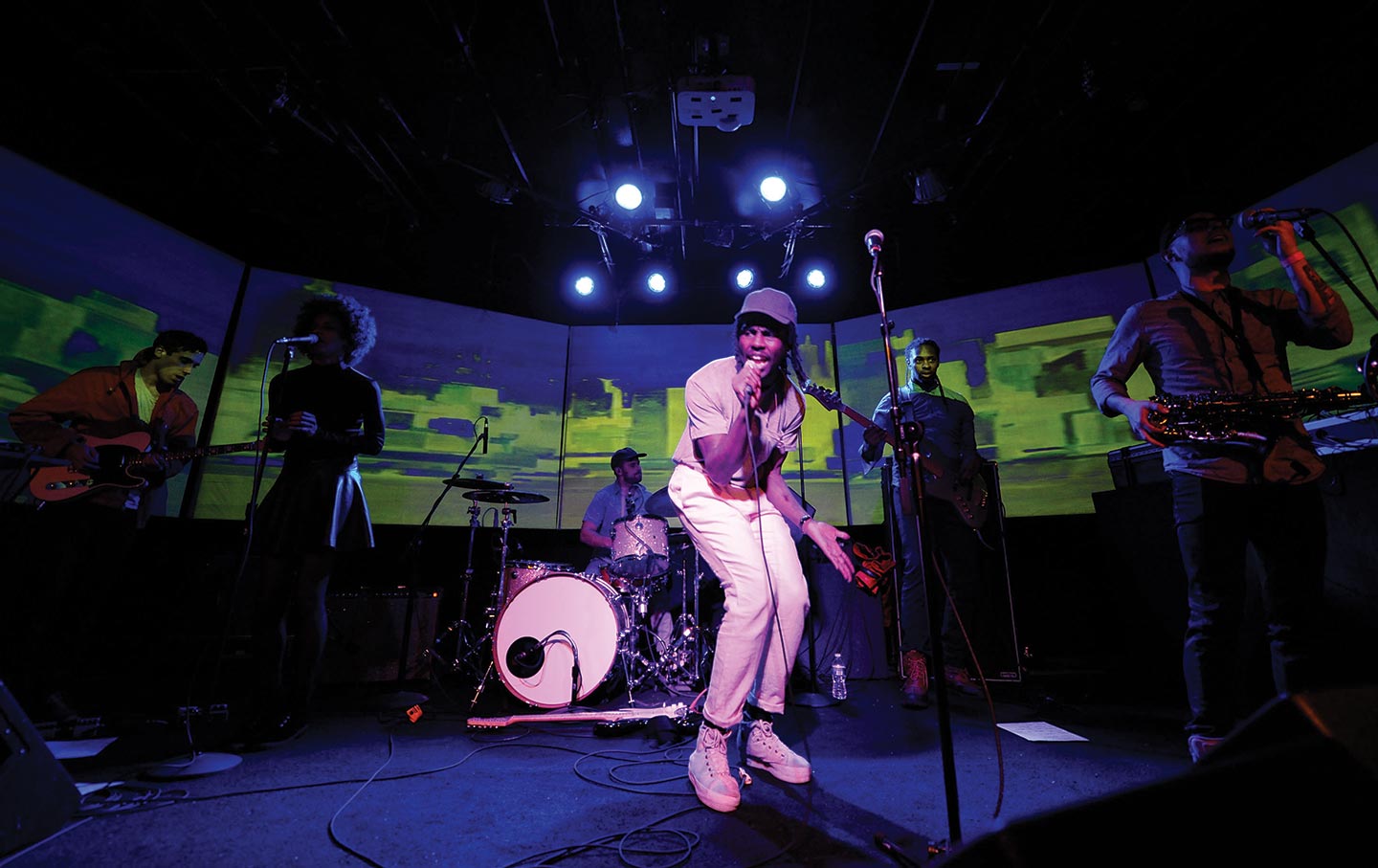What James Baldwin Saw
A documentary that follows the writer’s late-in-life journey to the South chronicles his vision for Black politics in a post–Civil Rights era world.

We begin with an image that conjures all manner of unspeakable horrors: the crumpled grimace of a Klansman. With this black-and-white photo—the first in a series of vintage pictures—the film I Heard It Through The Grapevine (1982) announces a history of violence known and unknown. Recently restored through the efforts of the Harvard Film Archive, the documentary, directed by the filmmakers Dick Fontaine (who died last October) and Pat Hartley (a former actress who appeared in the 1972 underground film Ciao! Manhattan), pulls back to reveal James Baldwin bent over these photographs, which convey him—musing aloud—some 20 years into the past. He mourns his friends Medgar Evers, Malcolm X, and Martin Luther King Jr. In 1980, when this sequence was filmed, Baldwin would have been in his mid-50s, but none of these men—whose names fall from his tongue like hushed embraces—ever saw 40. The film that follows, Baldwin reveals, concerns instead the “roll call of unknown, invisible people who did not die, but whose lives were smashed on the freedom road.” Grief had transformed him and the South, significantly, on that perilous journey down “freedom road.” Fontaine and Hartley’s documentary maps those turbulent years when the civil rights movement climbed to its apex, through the recollections of Baldwin and other activists and intellectuals.
Baldwin first journeyed to the South in 1957, summoned back to his native country (on which he’d kept a watchful eye from Paris) by efforts to integrate the public schools, which the white populace and law enforcement met with feral, often murderous indignance. The film trails him through Atlanta; Birmingham and Selma, Ala.; Bunkie, La.; and various other pit stops across the South in the 1980s, when he returns, at least in part, to survey the afterlife of the civil rights era’s achievements and, in more than one instance, the deteriorating conditions of the Black populations in the cities he revisits. Along the way, he reunites with old friends and longtime comrades, an impressive roster of luminaries: Sterling Allen Brown, Hosea Williams, Fred Shuttlesworth, Lonnie King (cofounder of the Atlanta Student Movement), Oretha Castle Haley, Amiri Baraka, and Chinua Achebe. Like Baldwin, they have all lived long enough to be miserably disappointed. Lonnie King tells the writer that, in retrospect, their expectations were too low. “Had we taken a broader view,” King says, “we would’ve known that the battle really wasn’t about integration, but it was about economics.” Indeed, Hosea Williams explains in one scene that he believes the real reason King was assassinated was that he had turned his sights to the redistribution of wealth.
The film stitches past and present together in a collage of ongoing protest, the cries of the politically committed kindled with derision for what has widely passed as progress despite having fallen woefully short of their demands. The statehouses of Georgia and Louisiana are now swelled with newly elected Black officials, but these victories have been almost entirely cosmetic—little more than pageantry—when economic disparity has spiraled otherwise unchecked. The marble monuments and towering high-rises of the modern urbanscape, emphasized by Fontaine and Hartley, render a hollow portrait of contrition and prosperity. Baldwin appears before a number of concrete courthouses, looming brutalist structures that cast a chilling shadow upon the civilians strolling below. Chromatic, present-day scenes are intertwined with (and often resemble) archival black-and-white footage of marches, speeches, protests, press conferences, and the all-too-familiar imagery of violent mob assaults; decades collapse within the blink of a swift cut, knotting the timelines together.
When Oretha Castle Haley brings up the panicked, menacing outcry over crime rates, inevitably Black bogeymen (children, at that), and expanding incarceration—which she likens to “concentration camps”—her words reverberate with haunting precision more than 40 years later. As Castle Haley, perched on her couch in the early 1980s, observes: “When [Lyndon B. Johnson] finished, his final sentence was ‘We shall overcome.’ And I mean, the minute I heard him say that, I understood clearly that…this is really going to be a long, long protracted struggle because…” Abruptly, a black-and-white interview of the younger Castle Haley intervenes at this point, revealing a dispiriting continuity: “The fact is, this is a hypocritical effort…to gain cheap publicity.” These editorial flourishes achieve a striking result: We are compelled to confront not merely this country’s political life as a kind of static theater caught in an endless loop, but also its willful, determined reversals. Time folds and traps its denizens, shoving them ever backward.
Perhaps more than any other place in America, the South has made a point of enshrining its past in myth and stone; the past is at once inescapable and veiled in fantasy, tasked with preserving an altogether fearsome and precarious pride. On his forays out of the city, where sprawling verdure cradles the dusty, winding roads, Baldwin reflects from the car: “You are aware of the trees. You are aware of how many of your brothers hung from those trees.” The countryside offers no respite from the hard, steely edges of the metropolis. But the famously itinerant New Yorker—born in Harlem in 1924 (this year will mark his centennial)—would regard this venture as a (not quite divine) pilgrimage.
In Florida, he and Achebe visit an old slave market, where Baldwin says to his friend: “And this is where you and I met 100 years ago. You were chained to me, and I was chained to you.” Although he often wrote of the peculiar detours where the region promised certain curious or otherwise fatal divergences, he would repeatedly return to “the auction block” in his writing. For him, it was at once an unrelenting specter, the birthplace of Black music and kinship, and the graveyard of white European claims to humanity and hierarchy. The auction block was the defining thread that psychically arranged Black and white American life alike. One could never really outrun this ancestral scene, whether you found yourself on a street corner in Harlem or in St. Augustine, Fla. Notice that here Baldwin makes no distinction between himself and Achebe, a Nigerian. For they return not so much to a place, but to a moment of violence and rupture. “Ancestral and daily are synonyms,” Baldwin once wrote. Indeed, as this film attests, the past is never really past; it constantly spills into the present and forges the scaffold on which the future is compelled to unfold in the model outlined by its forebears. Inheritance, therefore, is everything.
Language operated as the stage on which Baldwin’s whole life was built. He was raised in the Pentecostal tradition (where “speaking in tongues” is an exercise in faith), a preacher by age 14 and celebrated, by the time he deserted the church entirely, at 17. He was in possession of an extraordinary instrument: His voice could hold a room captive in silence. Most filmmakers have instinctively understood that it is best to let Baldwin speak for himself and at length. Fontaine and Hartley know this too, but their film also makes apparent what a keen listener and, therefore, observer he was.
At various moments, the camera steals a stray, glancing shot of his wide-eyed gaze amid a crowded gathering. Elsewhere, it lingers on Baldwin’s face or profile or situates him in a visible if not quite prominent corner of the frame, as if to order subsequent happenings (visually and narratively) within his vantage. The camera bestows upon him (fittingly) an authorial post: He is narrator and guide. Nearly 40 years after his death, he still occupies much the same space in the public mind on racial matters (albeit narrowly, it must be said, for he also left behind a formidable corpus of film, literary, and music criticism). For better or worse, we continually reach back for Baldwin’s words, for they never fail, however liberally applied, to satisfy the moment. This was his gift: He could face the truth unflinchingly, and his legacy remains an ever reliable framework with which to bridge this country’s tortured self-estrangement.
If the film anoints Baldwin as its interlocutor—the bridge between past and present—then children emerge as its true orbit. Far from a requiem to a long-lost age, the film becomes a tribute (however clouded by the dawn of Reagan) to the one coming, as the elders rest their tremulous hopes at the feet of the newest generation. An unfair burden, perhaps, but then again, children had always been on the front lines of this struggle. The filmmakers devote a chapter to Ben Chaney, the younger brother of James Chaney, one of three activists—along with Andrew Goodman and Michael Schwerner—murdered by Klansmen and police in Mississippi that terrible summer of 1964. At his brother’s funeral, cameras capture the then-12-year-old Ben, a diminutive boy, heaving shallow breaths through his tears. He perseveres, with melancholy determination, singing the hymn “We Shall Overcome” through anguished sobs. But this is not a tale of resilience: We learn that, years later, Chaney was accused and convicted of murder in Florida.
Throughout I Heard It Through the Grapevine, we glimpse the guileless faces of local children, weaving through the playground or the neighborhood or peering up at their elders in a crowded classroom; on his brief excursion to New Jersey, the kids contend for proximity to Baldwin. Plunged back into the past, we encounter a bitter doubling: grainy footage of very similar guileless faces and wiry bodies huddled together, this time in a jail cell. In 1963, more than 1,000 children had marched in the Birmingham Children’s Crusade, and police had jailed them by the hundreds. Just a few months later, also in Birmingham, four little girls perished in the bombing of the 16th Street Baptist Church.
What remains unsaid is of equal relevance. The timeline of production suggests that for at least some of the time that we find Baldwin in Atlanta, he was likely on assignment, reporting on the murders of at least 28 children and two adults who were killed there between 1979 and 1981. The Atlanta child murders threatened to destroy the city, just as it teetered on the verge of remaking itself into the vision of a thriving, progressive Black metropolis. Baldwin published his findings in his 1985 book The Evidence of Things Not Seen, in which he elucidates many of the same concerns raised in the film, for he could not tell the story of stolen and murdered children without exposing the poverty, the incompetence, and the wanton cruelty of the American justice system and all the many other horrors that conspired daily to imperil them. Baldwin never had much confidence in the state: “There is no refuge from confession but in suicide,” he narrates, scored by the lively chords of a gospel interlude. In the end, he places his faith in those who remain, the heirs to this long struggle, the path ahead forged in dignity.
Disobey authoritarians, support The Nation
Over the past year you’ve read Nation writers like Elie Mystal, Kaveh Akbar, John Nichols, Joan Walsh, Bryce Covert, Dave Zirin, Jeet Heer, Michael T. Klare, Katha Pollitt, Amy Littlefield, Gregg Gonsalves, and Sasha Abramsky take on the Trump family’s corruption, set the record straight about Robert F. Kennedy Jr.’s catastrophic Make America Healthy Again movement, survey the fallout and human cost of the DOGE wrecking ball, anticipate the Supreme Court’s dangerous antidemocratic rulings, and amplify successful tactics of resistance on the streets and in Congress.
We publish these stories because when members of our communities are being abducted, household debt is climbing, and AI data centers are causing water and electricity shortages, we have a duty as journalists to do all we can to inform the public.
In 2026, our aim is to do more than ever before—but we need your support to make that happen.
Through December 31, a generous donor will match all donations up to $75,000. That means that your contribution will be doubled, dollar for dollar. If we hit the full match, we’ll be starting 2026 with $150,000 to invest in the stories that impact real people’s lives—the kinds of stories that billionaire-owned, corporate-backed outlets aren’t covering.
With your support, our team will publish major stories that the president and his allies won’t want you to read. We’ll cover the emerging military-tech industrial complex and matters of war, peace, and surveillance, as well as the affordability crisis, hunger, housing, healthcare, the environment, attacks on reproductive rights, and much more. At the same time, we’ll imagine alternatives to Trumpian rule and uplift efforts to create a better world, here and now.
While your gift has twice the impact, I’m asking you to support The Nation with a donation today. You’ll empower the journalists, editors, and fact-checkers best equipped to hold this authoritarian administration to account.
I hope you won’t miss this moment—donate to The Nation today.
Onward,
Katrina vanden Heuvel
Editor and publisher, The Nation







